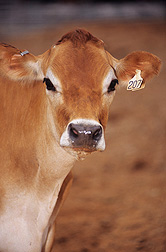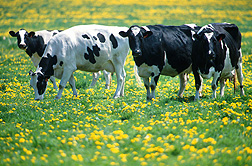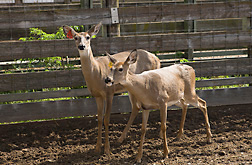Overcoming Hurdles To Eradicate Tuberculosis in Cattle
Published: September 3, 2013
By: Sandra Avant, Agricultural Research Service Information Staff, USDA
Although the prevalence of bovine tuberculosis (TB) is low in the United States, the bacterial disease can still infect cattle, wildlife, and humans. Complete eradication is not likely as long as Mycobacterium bovis, the causative agent of bovine TB, exists in wildlife, which can transmit the bacteria to cattle, and as long as available tests cannot accurately detect all TB-positive cattle from Mexico before they are imported.
Scientists in the Infectious Bacterial Diseases Research Unit at the Agricultural Research Service’s National Animal Disease Center (NADC) are collaborating with international partners, the USDA’s Animal and Plant Health Inspection Service, industry, and private companies to develop new methods to prevent and control TB in cattle and wild white-tailed deer in the United States.
Other countries with wildlife reservoirs of TB have been unable to eradicate the disease from cattle. Research to help control the disease targets wild boars in Spain, brushtail possums in New Zealand, and badgers in the Republic of Ireland and the United Kingdom.
Strategies for both U.S. and international scientists include developing and improving TB tests and finding effective methods like vaccination to stop the spread of the disease.
Widespread pasteurization of milk, development of a diagnostic tuberculin skin test for cattle, and establishment of an eradication program by the U.S. Department of Agriculture significantly helped decrease the incidence of bovine TB in humans in the United States.
Obstacles Are Skin Deep
Although the cattle skin test has helped eradication efforts, it has drawbacks.
“The test is not sensitive enough and requires a 72-hour waiting period for results,” says NADC veterinary medical officer Mitch Palmer. “It’s very difficult to test a herd of 100 cows and say that this one has TB and this one doesn’t, because the test may not detect one or two animals that actually have TB.”
A practice called “test and remove” is an option for farmers who have herds infected with TB, but the usual method is to euthanize all animals, even if only one has TB, Palmer says. A huge push is under way to develop a better test that will help producers identify and remove infected animals and keep those that are disease free.
Interferon-gamma-release assays, used to detect TB, are whole-blood tests that require live white blood cells to work. Fresh blood samples cannot get too hot and must be processed within 8-30 hours, which means getting samples to a lab in good condition within a reasonable timeframe, says NADC veterinary medical officer Ray Waters.
Tests that require only the liquid part of the blood—the serum—would be more convenient and less expensive, Waters says.
The problem is identifying antigens that are very specific and sensitive for use in serum tests, he says. An antigen is a substance—like foreign bacteria or viruses or matter within the body—that causes the immune system to produce antibodies against it.
Contributing to New Tests
Over the last 12 years, NADC scientists have shown that improved antigens, such as one known as “MPB83,” are crucial in developing effective assays, Waters says. These findings have played a key role in a new serum TB diagnostic test, developed by IDEXX Laboratories, Inc.
The test has been added to the World Organization for Animal Health registry and licensed by USDA’s Center for Veterinary Biologics. It was created using IDEXX’s proven enzyme-linked immunosorbent assay (ELISA) method and based on NADC’s research that shows MPB83 is a useful antigen for bovine TB antibody-based tests.
“This was a team effort,” Waters says. “IDEXX used samples from our experimental infection trials, and we helped the company validate and optimize the test. We then assisted with a worldwide field analysis with colleagues in the United Kingdom, New Zealand, and Ireland to verify the test’s sensitivity and specificity.”
“The ELISA format involves testing the animal’s serum to see if it has antibodies that will react to certain components of the bacteria,” Palmer says. “In addition to providing the animals, we discussed what antibodies might be best to look for, based on findings in our lab and others and on the general immune response of cattle to infection with M. bovis.”
This test is more convenient and could potentially be used in combination with skin and interferon-gamma tests to identify undetected TB-infected animals, Waters says. “It’s another tool in our diagnostic tool kit.”
The serum test is available to countries that want to add it to their list of approved eradication-program tests. Until recently, the skin and interferon-gamma tests were the only approved tests for use on U.S. cattle, Waters adds. But the United States recently approved serum tests for use with samples from deer and elephants. Both tests were manufactured by Chembio Diagnostic Systems in close collaboration with Waters and Palmer. Even more recently, the IDEXX M. bovisELISA test was approved for use with samples from cattle.
Keeping It Fresh
Another type of test—based on polymerase chain reaction (PCR) analysis of DNA—has been developed by NADC microbiologist Tyler Thacker and his colleagues. The new PCR test detects M. bovis in fresh tissues rather than the traditionally fixed tissues prepared for viewing under a microscope. It helps distinguish between M. bovisand environmental mycobacteria that can cause false-positive outcomes.
“The objective was to be able to confirm M. bovisin fresh tissue to speed up the process,” Thacker says. “That way we wouldn’t have to wait potentially 2 months for the bacterium to grow.”
Thacker looked at different PCR assays and discovered that many also picked up mycobacteria that were not M. bovis.
The scientists developed a method to eliminate the environmental mycobacteria from test results. They sequenced a region of the bacterium’s DNA and developed a real-time PCR probe to help distinguish between M. bovis and other mycobacteria. The newly developed assay was tested against 11 mycobacterial species commonly cultured from diagnostic samples. Specificity for detecting M. bovis was 100 percent and sensitivity was 67 percent in samples from 30 infected and 18 uninfected animals.
“The specificity of the new PCR is the most important result,” Thacker says. “The fact that it’s quicker than a traditional PCR is an added benefit.”
A Century-Old Vaccine for Deer
For more than 100 years, the Bacillus Calmette-Guerin (BCG) vaccine has proven to be safe and partially effective against TB in humans. The BCG vaccine was first tested in cows and showed protection against virulent M. bovis. Soon afterwards, it was used in humans and demonstrated protection against M. tuberculosis, the most common cause of TB in humans.
“Rather than trying to reinvent the wheel, BCG seemed like a logical choice to try with deer,” Palmer says. “We’re looking at its efficacy in deer. Does it actually protect them? Are there any undesirable side effects? Is it safe to use in deer that may become food for hunters?”
Today, several different strains of BCG are used to vaccinate humans in countries where TB is still a problem. But BCG is not used in the United States, because people who are vaccinated with it might test positive when given a TB skin test, even if they don’t have the disease.
“The concern wasn’t that BCG was going to hurt people. It doesn’t produce disease or cause an infection,” Palmer explains. “The concern was that if a person ate venison from deer vaccinated with BCG and subsequently had a skin test for TB, the result might be a false positive.”
NADC scientists conducted studies to find out how long BCG remains in tissues of vaccinated deer. A BCG oral bait vaccine, developed by New Zealand collaborators for the brushtail possum, was fed to captive deer at a standard dose and at 10 times the standard dose. Examination of deer 1 to 12 months after vaccination showed no traces of BCG in deer given a standard dose. But BCG was detected at 12 months in deer that received the elevated dose.
“Importantly, BCG vaccine was never found in common cuts of deer meat, regardless of whether it was given orally or by subcutaneous vaccination, in any of our safety experiments,” Palmer says. “We’ve never found it in the muscle, but only in lymph nodes and other tissues that aren’t commonly used for food by humans. So it seems to be safe to use in deer.”
Although the BCG bait, which resembles a hard cookie, worked well for captive deer in Iowa, it did not appeal to wild white-tailed deer in Michigan.
Palmer and his team are collaborating with scientists at USDA’s National Wildlife Research Center in Fort Collins, Colorado, to develop a new bait to deliver the BCG vaccine to deer. They are experimenting with apple, acorn, and peanut butter flavors in hopes that one of these will whet the appetite of wild deer and provide an effective vaccination delivery method.
This research is part of Animal Health, an ARS national program (#103) described at www.nps.ars.usda.gov.
This article was published in the September 2013 issue of Agricultural Research magazine. Engormix thanks for this contribution.
Source
Sandra Avant, Agricultural Research Service Information Staff, USDAAuthors:

Recommend
Comment
Share

Would you like to discuss another topic? Create a new post to engage with experts in the community.










